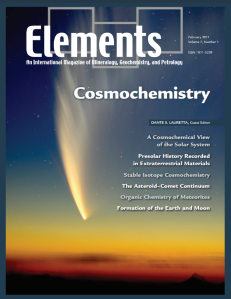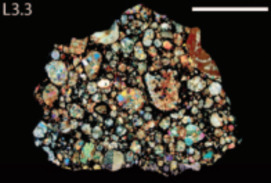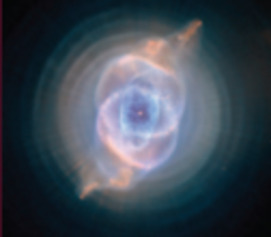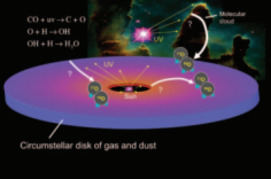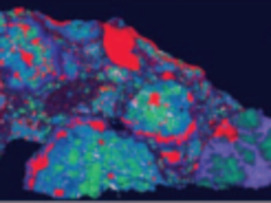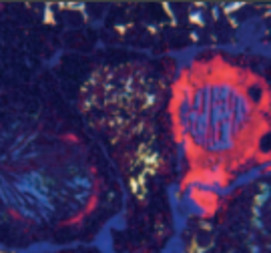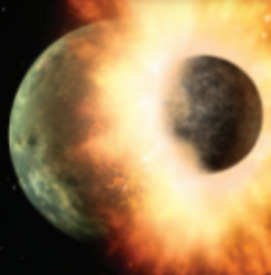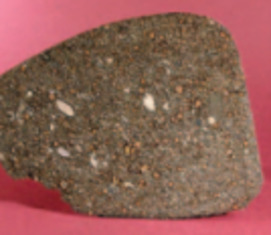
Cosmochemistry
Dante S. Lauretta – Guest Editors
Table of Contents
Cosmochemistry is the study of extraterres trial materials aimed at understanding the nature of Solar System bodies, including the planets, their natural satellites, and small bodies. An important goal is to increase our understanding of the chemical origin of the Solar System and the processes by which its planets and small bodies have evolved to their present states. Research in cosmochemistry covers a wide range of disciplines and tech niques, including mineralogy, petrology, major and trace element chemistry, isotope compositions, radiometric ages, magnetism, and radiation exposure effects. These studies provide a wealth of data about the processes of stellar evolution, planetary system formation, alteration in asteroidal and cometary interiors, and the accretion history of the Earth, including the origin of Earth’s volatile and organic material.
- A Cosmochemical View of the Solar System
- Presolar History Recorded in Extraterrestrial Materials
- Stable Isotope Cosmochemistry and the Evolution of Planetary Systems
- The Asteroid–Comet Continuum: In Search of Lost Primitivity
- Organic Chemistry of Carbonaceous Meteorites
- Chronometry of Meteorites and the Formation of the Earth and Moon
- Meteorites: An Overview
Australian Scientific Instruments (ASI)
Bruker
Cambridge University Press
CAMECA
Cosmochemistry Illustrated
Dakota Matrix Minerals
Excalibur Mineral Corporation
Geological Society of london
ICAM 2011
Meteorite Magazine
PSRD Discoveries
RockWare
Savillex
SPECTRO
v7n2 IRON IN EARTH SURFACE SYSTEMS
Guest editor: Kevin G. Taylor and Kurt O. Konhauser
Iron is the fourth most abundant element at the Earth’s surface. As an essential nutrient and electron source/sink for the growth of microbial organisms, it is metabolically cycled between reduced and oxidized chem ical forms. This flow of electrons is invariably tied to the reaction with other redox sensitive elements, including oxygen, carbon, nitrogen, and sulfur. The end result of these interac tions is that iron is intimately involved in the geochemistry, mineralogy, and petrology of modern aquatic systems and their associated sediments, particulates, and pore waters. In the geological past, vast iron sediments, the so called banded iron formations, suggest that iron played an even greater role in marine geochemistry, and these deposits are now being used as proxies for understanding the chemical composition of the ancient oceans and atmosphere. This issue will explore not only the modern expression of iron cycling but also its record in Earth’s history.
- Iron in Earth Surface Systems: A Major Player in Chemical and Biological Processes Kevin G. Taylor (University of Manchester) and Kurt O. Konhauser (University of Alberta)
- IRON IN MICROBIAL METABOLISMS Kurt O. Konhauser (University of Alberta), Andreas Kappler (University of Tübingen), and Eric E. Roden (University of Wisconsin–Madison)
- Geomicrobiology of Iron in Extreme Environments Alexis S. Templeton (University of Colorado)
- Iron Transport from the Continents to the Open Ocean: The Aging–Rejuvenation Cycle Robert Raiswell (University of Leeds)
- Ferruginous Conditions: A Dominant Feature of the Ocean through Earth’s History Simon W. Poulton (Newcastle University) and Donald E. Canfield (University of Southern Denmark)
- Iron Minerals in Marine Sediments Record Chemical Environments Kevin G. Taylor (University of Manchester) and Joe H. S. Macquaker (Memorial University of Newfoundland)
- Iron Ore Deposits Associated with Precambrian Iron Formations Bruce M. Simonson
- Cosmochemistry (February 2011)
- Iron in Earth Surface Systems (April 2011)
- Global Water Sustainability (June 2011)
- When the Continental Crust Melts (August 2011)
- Tourmaline (October 2011)
- Mine Wastes (December 2011)
Download 2012 Thematic Preview


